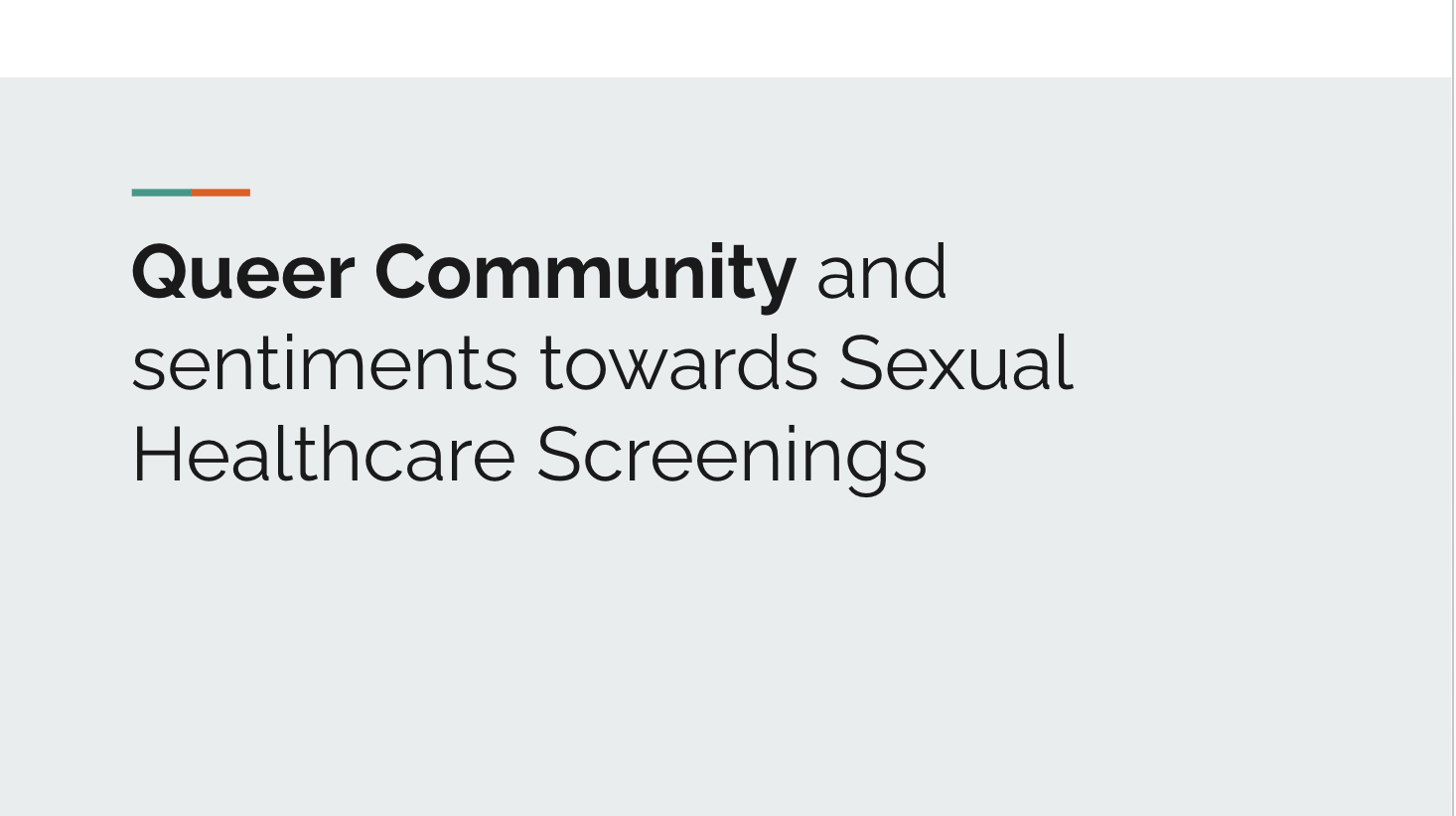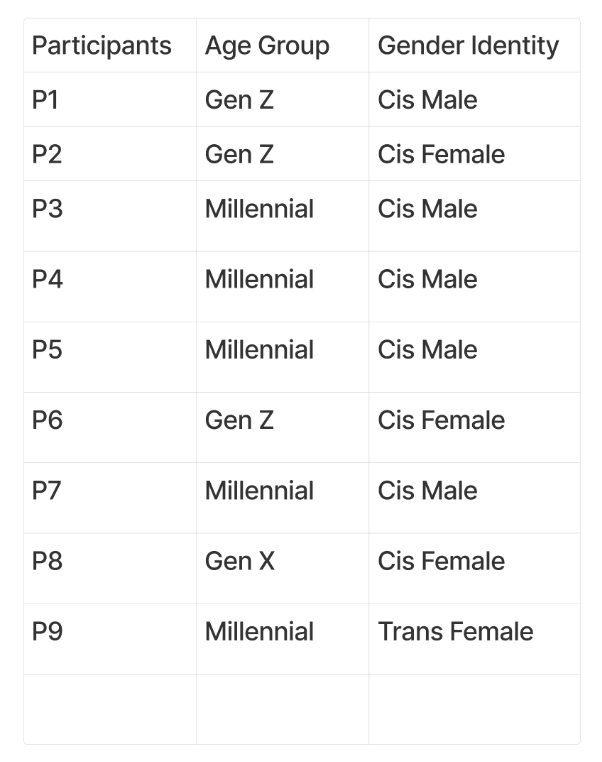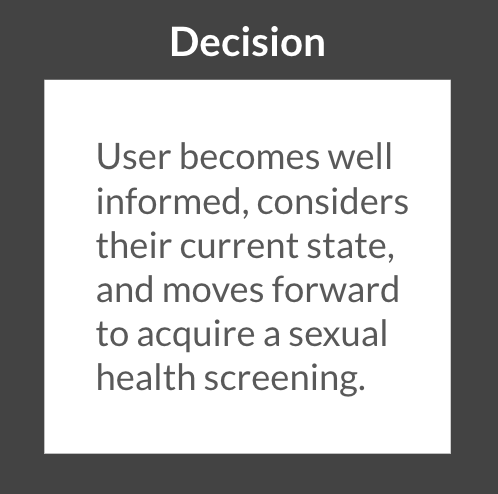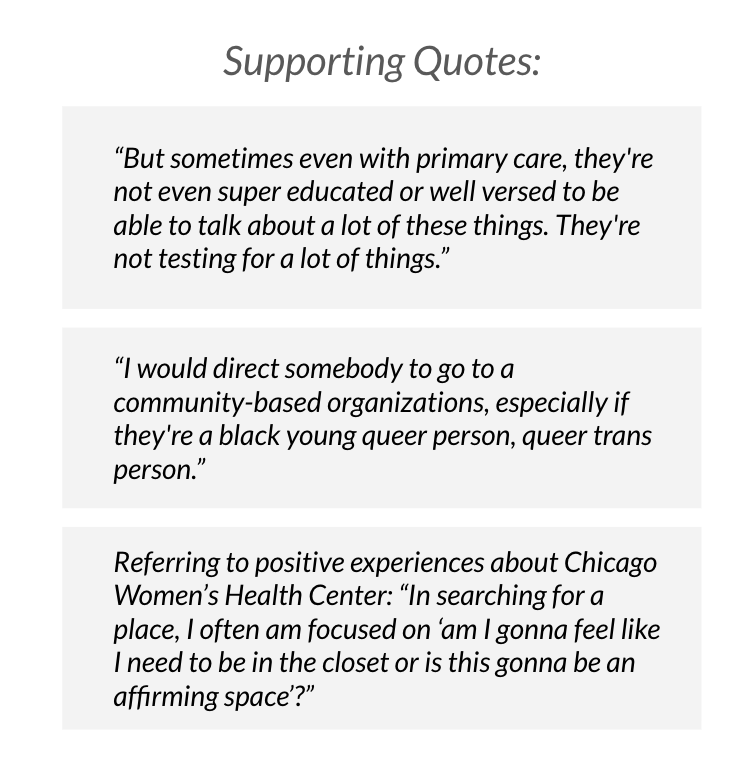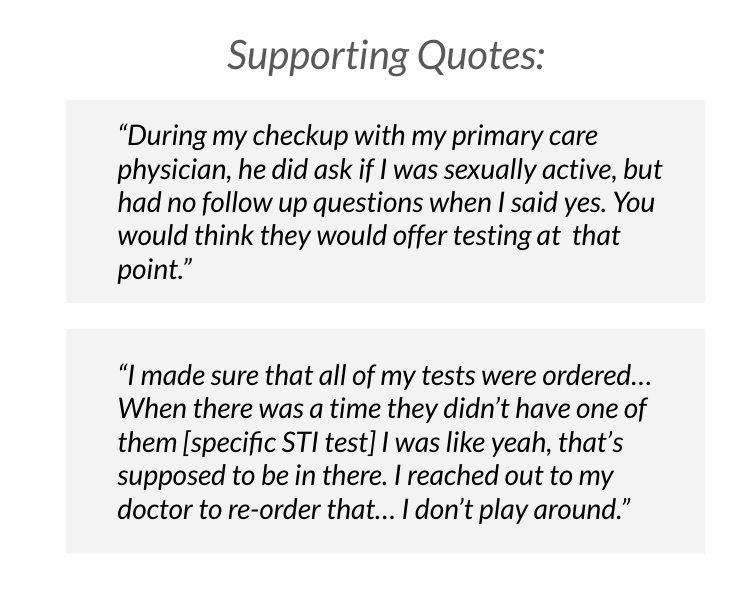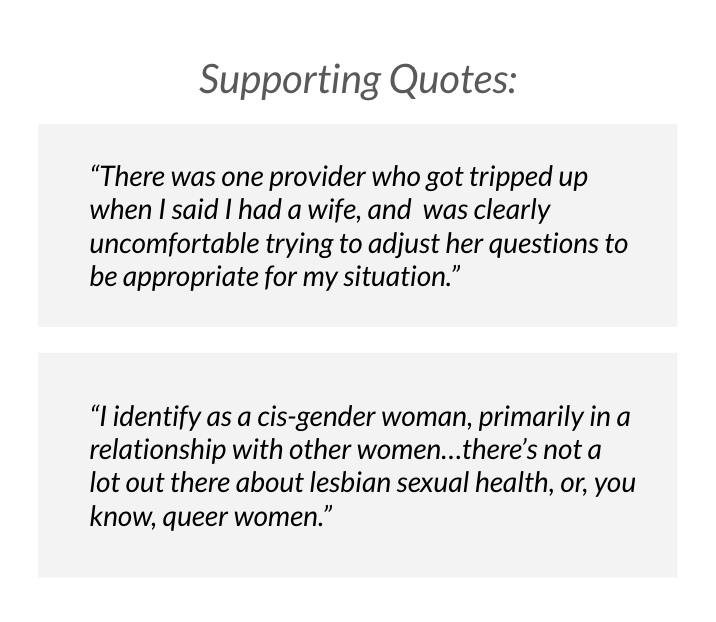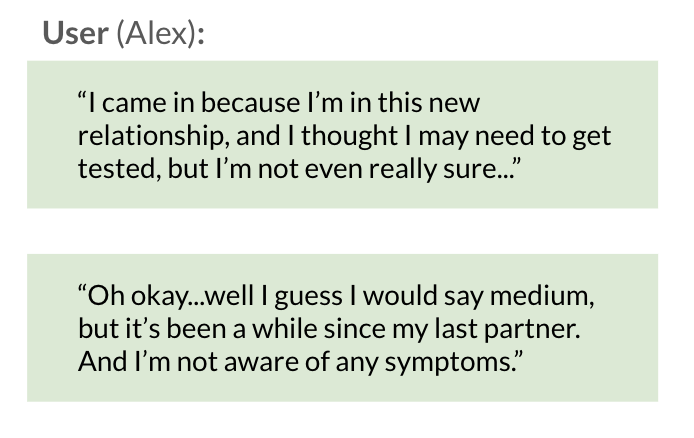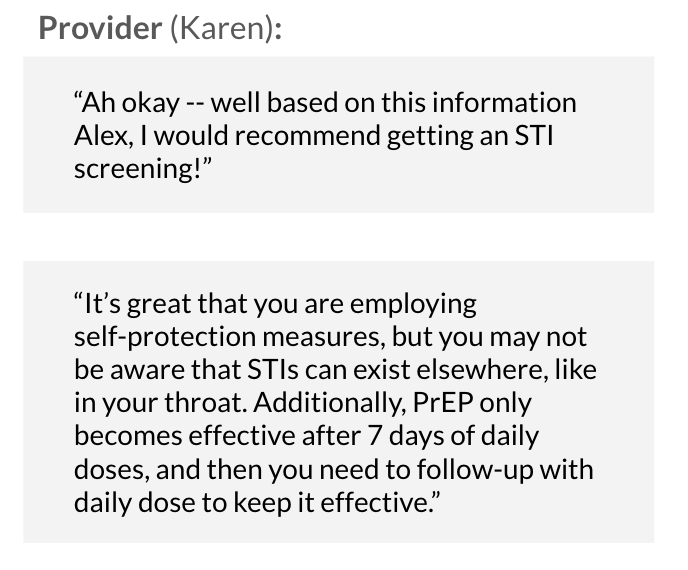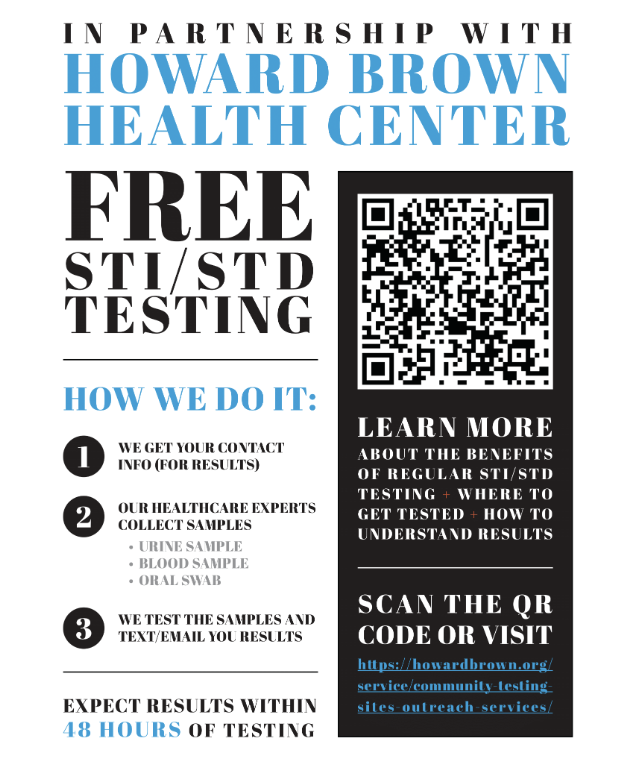Behavioral Science and UX Design
Role: Researcher
Tool: Optimal Workshop & Figma
Research Questions
Accessing sexual health services, often [lacks] “cultural competency” (Waryold & Kornahrens, 2020).
The Problem Area
Why is it important to focus on improving sexual healthcare for LGBTQ+ individuals?
What interventions can be introduced to…
Question 1:
…further educate members of the LGBTQ+ community on sexual healthcare?
Question 2:
…encourage members of the LGBTQ+ community to receive regular sexual health screenings?
Target Audience
LGBTQ+ individuals
20+ years old
I interviewed 9 participants who identify as part of the LGBTQIA+ community about their experiences with sexual health education, healthcare, and screenings.
Interview Data
Journey Map Focus
For the journey map, I decided to focus on the STI screening process. Emerging themes were used to create user journeys, organizing each step into its’ corresponding stage: Awareness, Decision, and Response.
User Journey
Using themes from interview data, I decided to create user journeys and organized each step into its’ corresponding stage:
User Journey | Awareness
Examples:
User Journey | Decision
Awareness can be broadly defined as our user encountering or interacting with sexual health information that then generates (or engenders) a consideration for STI testing.
Advertisements (billboards, commercials, social media)
Increased sexual activity
Discussions with referential network (i.e., friends or partners)
Annual reminders for appointments
Examples:
User becomes well informed, considers their current state, and moves forward to acquire a sexual health screening:
Talks with referential network
Makes appointment with Primary Care Physician (PCP)
Requests an STI screening as part of their annual checkup
Inflection Point: Through enablers, user identifies a path to acquire an STI screening
User Journey | Response
In the final stage of the user journey, they react to what occurred during the decision phase, namely the STI screening.
Examples:
Based on results, PCP advises next steps or regimen (if outcome is pharmaceutical)
User can inform sexual partners of status
User can better assess their actual risk based on their sexual activity
Emerging Themes
Four themes were established through interview data and a card sorting activity through Optimal Workshop.
In conducting interviews with LGBTQ+ participants, I uncovered a lot of detail surrounding their experiences with healthcare providers and their first introduction to sexual healthcare education.
Across stories, there were many repeated elements, which were pulled out into emerging themes to focus on for the intervention…
Emerging Theme 1
Sexual healthcare education is broached from two lenses:
Reproduction
Gendered distinctions
Emerging Theme 2
LGBTQ+ members have had more success utilizing community-based organizations for sexual health services.
Emerging Theme 3
Providers often fail to offer proper healthcare to sexually active individuals, unless directly requested.
Emerging Theme 4
Sexual healthcare experiences widely vary across groups within the queer community.
Let’s Talk Strategies
The journey map had a deep focus on the STI screening process where I discovered the effects of enablers, barriers and decision levers had on each stage.
Before designing the intervention…
Outlined user goals and motivations
Identified supporting actors and stakeholders
Identified enablers, barriers, and decision levers in each stage of the user journey
Design Strategy | Main Actor
User Goals:
What high level needs does the user have that will be met with your behavioral intervention?
Gender-affirming space to receive sexual health (especially STD/STI) screenings
Healthcare provider who understands user’s specific needs as a member of the LGBTQIA+ community
Accessible and affordable screening options
Online portal to view results quickly
Design Strategy | Enablers
Awareness Stage
Education
Pharmaceutical marketing campaigns
Queer representation
Design Strategy | Barriers
Awareness Stage
Educational systems
Marketing campaigns
Health care systems
Design Strategy | Decision Levers
Awareness Stage
Targeted/General marketing
Scenario-based learning
Normalized spaces for
conversation
Design Concept | Prioritization
Design Concept | Final Design Intervention
User Motivations:
Why is the individual doing what they are? What is driving them towards completion of a goal?
User is entering relationships with multiple sexual partners after some time and wants to make sure they are protecting everyone’s health.
User wants to learn more about healthy sexual behaviors to ensure future partners feel comfortable discussing sexual health with them
Decision Stage
Agency
Goal Alignment
Rapport with PCP
Power dynamics
Decision Stage
Power dynamics
Lack of sexual health education
Poor mental models
Response Stage
“After Care” summaries
Community Prevalence
Partner Responsibility
Response Stage
Speed and accessibility of sexual relationships
Provider follow-ups
Decision Stage
Destigmatized positive STI results
Continuous sexual health
education
Response Stage
Digital channel for providers/ patients
Community conversations
When designing the intervention, It was decided to focus on awareness, since the intent/action gap is greatest in this stage of the user journey.
A conceptual “sex-ed office hours pop-up”, where LGBTQ+ members can receive free sexual health advice and recommendations.
A scripted conversation between a user and a provider from the pop-up.
A scripted conversation between a user and their sexual partner.
A marketing campaign used in conjunction with the pop-up, directing users towards free and fast sexual health screenings.
User Script
Below is a screenshot of a storyboard depicting the use of the “sex-ed office hours” and a scripted conversation between a user and a partner and a user and a provider.
The conceptual “sex ed office hours” was created in hopes of establishing a discussion forum where staffed health advisors would be available to answer questions. Office hours are open to all and with a queer focus.
Design Concept | User & Provider Script
Design Concept | User & Provider Script
Design Concept | User & Partner Script
Design Concept | Marketing Campaign
To the right is a poster created as part of an imagined marketing campaign, used in conjunction with our sex-ed pop-ups.
Marketing campaign flyers would be posted throughout the conceptual '“Sex ed office” to educate, promote, and encourage STI testing.
The poster outlines:
A trusted healthcare partner
What you’re getting
How the test is done
How long you get results
More info, if needed
Next Steps
Considerations on how to further this work to take this project to the next level include the following…
Design Concept | Feedback
Poster
Use a more approachable font
Use more concise language
Add images
Visually pleasing
Conveniently placed QR code
Next Steps | Further Research
With such a sensitive topic, it is important to revisit the research phase to collect more user input before continuing on with the design concept…
Revise interview script based on preliminary research results.
Script
Define who the script is for
Target the audience, the medical provider, or both
Well-articulated
After implementing design changes based on further research, I could test the intervention in a controlled environment with willing participants…
Partner with a trusted LGBTQ+ community health org.
Widen the participant pool to ensure inclusivity.
Next Steps | Design Concept Pilot
Recruit participants to test a simulated sex-ed pop-up.
Process new data and revise current user journey.
Run pilot pop-up and record provider/ user conversations.
Iterate on existing design concept with new research data.
Gather user feedback on their experience and iterate further.


